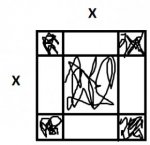(sorry, im not sure if this goes in geometry or intermediate geometry)

Question:If all the shaded quadrilaterals are squares, and their combined area is S, how do you prove that x^2/2=<S=<X^2
i started out by marking one of the sides of the smaller shaded squares as a parameter(b), then finding the equation for the area(f(x)=x^2-4xb-8b^2) then finding the derivative (f'(x)=2x-4b) but after that i got stuck, can anyone tell me what to do next?

Question:If all the shaded quadrilaterals are squares, and their combined area is S, how do you prove that x^2/2=<S=<X^2
i started out by marking one of the sides of the smaller shaded squares as a parameter(b), then finding the equation for the area(f(x)=x^2-4xb-8b^2) then finding the derivative (f'(x)=2x-4b) but after that i got stuck, can anyone tell me what to do next?
Last edited:
